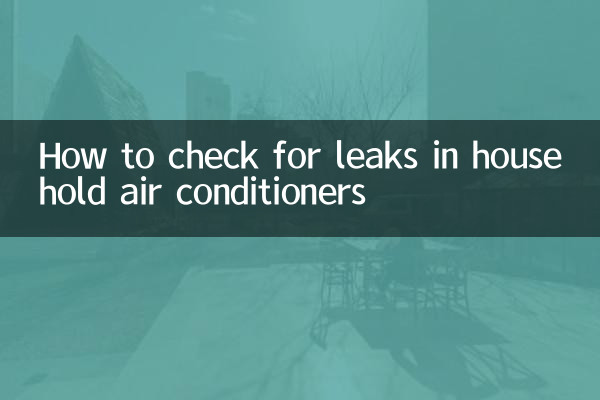How to check for leaks in household air conditioners
As high temperatures continue in summer, the frequency of use of household air conditioners increases sharply, and the decrease in cooling effect or frequent shutdowns of air conditioners may be caused by refrigerant leakage. This article will combine the discussions related to air conditioner maintenance that have been hot topics on the Internet in the past 10 days to introduce you in detail to the methods and precautions for leak detection in household air conditioners.
1. Common symptoms of fluoride leakage in air conditioners

| Symptoms | Possible reasons |
|---|---|
| The cooling effect is significantly reduced | Insufficient refrigerant leads to reduced heat exchange efficiency |
| The outdoor machine continues to operate without stopping. | Abnormal system pressure triggers protection mechanism |
| The indoor unit is frosted or icy | Insufficient refrigerant flow causes evaporator temperature to be too low |
| Obvious airflow sound can be heard | There is a leakage point at the pipe connection |
2. 5-step self-examination method
According to popular tutorials on home appliance repair forums, the following self-check steps are recommended:
| steps | How to operate | Tools |
|---|---|---|
| 1. Observe the joints | Check whether there are oil stains on the connecting pipe nut of the indoor and outdoor units | flashlight |
| 2. Soap water detection | Apply soapy water to suspicious areas and watch for bubbles | Soapy water + brush |
| 3.Auscultation examination | Use a stethoscope close to the pipe to listen for the sound of airflow | mechanical stethoscope |
| 4.Temperature test | Compare the normal air outlet temperature difference (should be ≥8℃) | Infrared thermometer |
| 5. Pressure detection | Measure operating pressure (R22 normal value 0.4-0.6MPa) | pressure gauge |
3. Comparison of professional leak detection methods
Comparison of three professional inspection technologies extracted from recent air conditioning maintenance industry reports:
| method | Accuracy | Cost | Applicable scenarios |
|---|---|---|---|
| Electronic leak detector | 85%-90% | ¥200-800 | Microleak detection |
| Fluorescence leak detection | More than 95% | ¥150-300/time | Hidden part detection |
| Nitrogen pressure holding | 100% | ¥300-500 | Acceptance after installation |
4. Statistics of high-frequency leakage parts
According to the analysis of 1,367 maintenance work orders on a maintenance platform in the past 10 days:
| Leakage site | Proportion | Typical performance |
|---|---|---|
| Four-way valve weld | 32.7% | Oil accumulation accompanied by air bubbles |
| bell mouth connector | 28.5% | Oxidation blackening with hissing sound |
| evaporator fins | 18.2% | Uneven local frosting |
| Compressor solder joints | 12.6% | Oil stains spread during operation |
5. Safety precautions
Based on the recent reports of many air-conditioning maintenance accidents, we would like to remind you:
1.It is strictly prohibited to check for leaks by open flame: Refrigerant will produce toxic phosgene when exposed to open flames
2. Be sure to cut off the power supply before operation, and wait for more than 5 minutes for the capacitor to discharge.
3. Safety belts must be worn when working at heights, and supervision is required when working at heights exceeding 2 meters.
4. When R32 refrigerant equipment leaks, it must be ventilated immediately to avoid concentration exceeding the limit (≥0.307kg/m³ has the risk of explosion)
6. Maintenance cost reference
The maintenance price range compiled based on the latest data from the consumer complaint platform:
| Maintenance items | Ordinary model | Frequency conversion model |
|---|---|---|
| Fix leaks and add fluoride | ¥150-300 | ¥200-400 |
| Replace connecting pipe | ¥180-350 | ¥250-450 |
| Evaporator repair | ¥300-600 | ¥400-800 |
It is recommended to choose a formal after-sales service agency and keep the charging voucher. If the annual refrigerant leakage is found to exceed 15%, the entire machine should be replaced according to the latest energy efficiency standards.

check the details

check the details